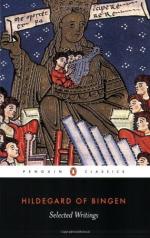|
This section contains 16,391 words (approx. 55 pages at 300 words per page) |

|
SOURCE: Peter Dronke, "Hildegard of Bingen," in Women Writers of the Middle Ages, Cambridge University Press, 1984, pp. 144-201.
In the following excerpt, Dronke draws upon "the twelve principal autobiographic passages that are still preserved in Hildegard's Vita in the form in which she set them down, " in order to discuss the genesis of Hildegard's visionary capacities, the gradual public acceptance of her prophetic voice, and her political sensibility as an abess.
I
Hildegard of Bingen still confronts us, after eight centuries, as an overpowering, electrifying presence—and in many ways an enigmatic one. Compared with what earlier and later women writers have left us, the volume of her work is vast. In its range that work is unique. In the Middle Ages only Avicenna is in some ways comparable: cosmology, ethics, medicine and mystical poetry were among the fields conquered by both the eleventh-century Persian master and the...
|
This section contains 16,391 words (approx. 55 pages at 300 words per page) |

|


